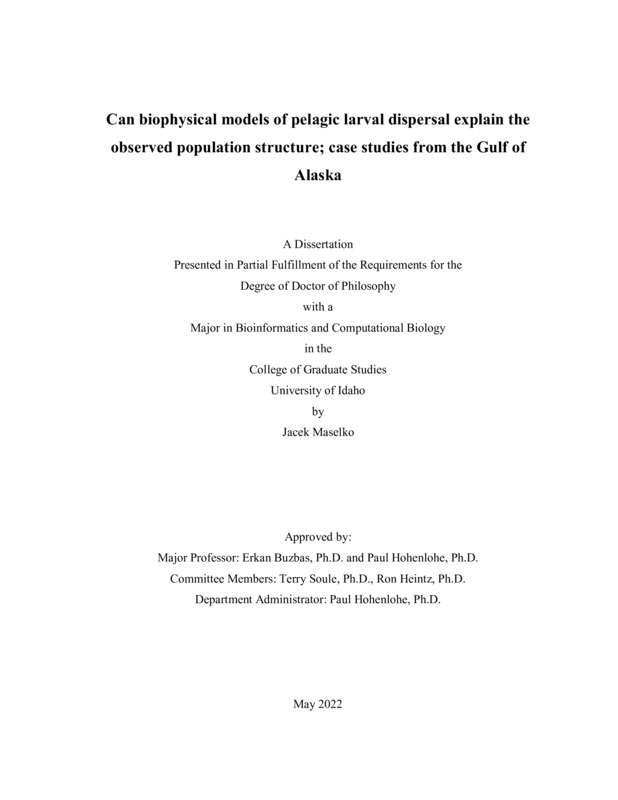Can biophysical models of pelagic larval dispersal explain the observed population structure; case studies from the Gulf of Alaska
Maselko, Jacek. (2022-05). Can biophysical models of pelagic larval dispersal explain the observed population structure; case studies from the Gulf of Alaska. Theses and Dissertations Collection, University of Idaho Library Digital Collections. https://www.lib.uidaho.edu/digital/etd/items/maselko_idaho_0089e_12360.html
- Title:
- Can biophysical models of pelagic larval dispersal explain the observed population structure; case studies from the Gulf of Alaska
- Author:
- Maselko, Jacek
- ORCID:
- 0000-0001-7235-1027
- Date:
- 2022-05
- Keywords:
- genomics landscape genetics ocean dispersal Population structure seascape genetics selective sieve
- Program:
- Bioinformatics & Computational Biology
- Subject Category:
- Bioinformatics; Statistics
- Abstract:
-
Numerous marine fish species have a characteristic pelagic larval dispersal stage. Understanding how this life history strategy affects the observed population structure of the adult groups and the adaptive potential of the species as a whole is therefore of paramount importance. In this study, I initially apply RAD-seq genomic analysis to examine the young of the year aggregates of Pacific ocean perch (Sebastes alutus) collected in 2014 and 2015 in the eastern Gulf of Alaska. I discover that these samples, even from the same haul, contain distinct genetic population mixtures indicating pelagic life stage sympatry. I also discover differences in selection strength between the two years, indicating that the maintenance of a portfolio of adaptive alleles may provide resilience of populations to natural environmental variability, where each adult cohort’s genetic composition is influenced by the environmental conditions experienced during their first year at sea. The apparent disconnect between pelagic stage sympatry and adult stage allopatry motivated the development of a stochastic spatio-temporal genetic model to understand the effect of biophysical dispersal on the population structure. Here, I develop the spatio-temporal genetic model utilizing a dispersal matrix and an allele frequency matrix which is then tracked over a number of generations. I then validate the genetic model with a suite of eight synthetic dispersal matrices and examine the inference via isolation by distance regression, STRUCTURE admixture analysis, and principal component analysis. This lead to unique insight into how each of these commonly used inference methods differs in their ability to differentiate among the synthetic candidate models. I then propose a log likelihood model selection framework based on the beta distribution as a viable alternate to determine which of the candidate dispersal models best explain the observed population structure based on pairwise F_ST values. Finally, I demonstrate the application of the newly developed spatio-temporal genetic model to calculate the expected population structure for three fish species in the Gulf of Alaska, namely, Pacific ocean perch (Sebastes alutus), arrowtooth flounder (Atheresthes stomias), and Pacific cod (Gadus macrocephalus). I use a biophysical dispersal matrix based on the Regional Ocean Modeling System (ROMS) and species specific ontogenic life stage behavior combined in a previously developed mode, the Dispersal Model for Early Life History Stages (DisMELS) to calculate the expected genetic differentiation. I then describe the expected population structure for these three species and apply the PCA, STRUCTURE admixture, and IBD regression inference. This is followed by the comparison of Pacific ocean perch and Pacific cod biophysical model based expected population structure and the observed genetic datasets which reconciles previously contradictory studies. I also demonstrate the application of this spatio-temporal genetic model to determine optimal sampling strategy in the log likelihood model selection framework. The results presented here also suggest that the biophysical based dispersal may be the primary driver behind the observed population structure in the marine species with life history strategies characterized by pelagic larval dispersal.
- Description:
- doctoral, Ph.D., Bioinformatics & Computational Biology -- University of Idaho - College of Graduate Studies, 2022-05
- Major Professor:
- Buzbas, Erkan; Hohenlohe, Paul
- Committee:
- Soule, Terence; Heintz, Ron
- Defense Date:
- 2022-05
- Identifier:
- Maselko_idaho_0089E_12360
- Type:
- Text
- Format Original:
- Format:
- application/pdf
- Rights:
- In Copyright - Educational Use Permitted. For more information, please contact University of Idaho Library Special Collections and Archives Department at libspec@uidaho.edu.
- Standardized Rights:
- http://rightsstatements.org/vocab/InC-EDU/1.0/

